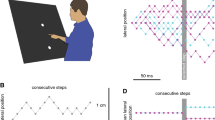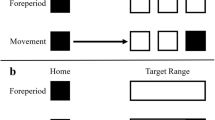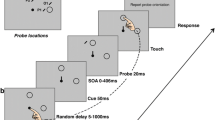Abstract
The present study investigated the impact of motor commands to abort ongoing movement on position estimation. Participants carried out visually guided reaching movements on a horizontal plane with their eyes open. By setting a mirror above their arm, however, they could not see the arm, only the start and target points. They estimated the position of their fingertip based solely on proprioception after their reaching movement was stopped before reaching the target. The participants stopped reaching as soon as they heard an auditory cue or were mechanically prevented from moving any further by an obstacle in their path. These reaching movements were carried out at two different speeds (fast or slow). It was assumed that additional motor commands to abort ongoing movement were required and that their magnitude was high, low, and zero, in the auditory-fast condition, the auditory-slow condition, and both the obstacle conditions, respectively. There were two main results. (1) When the participants voluntarily stopped a fast movement in response to the auditory cue (the auditory-fast condition), they showed more underestimates than in the other three conditions. This underestimate effect was positively related to movement velocity. (2) An inverted-U-shaped bias pattern as a function of movement distance was observed consistently, except in the auditory-fast condition. These findings indicate that voluntarily stopping fast ongoing movement created a negative bias in the position estimate, supporting the idea that additional motor commands or efforts to abort planned movement are involved with the position estimation system. In addition, spatially probabilistic inference and signal-dependent noise may explain the underestimate effect of aborting ongoing movement.





Similar content being viewed by others
Notes
The sudden movement abortion requirement implies high desired deceleration of the hand and short stopping time and distance. The CNS must specify motor commands, which correspond to force, to achieve this goal. In general, the stopping time and distance will emerge from the chosen motor commands and the current state of the system (i.e., position and speed) according to Newton’s second law of motion (F=ma). Therefore, the motor commands associated with movement termination are expected to be positively correlated with current movement speed.
References
Adamo DE, Martin BJ (2009) Position sense asymmetry. Exp Brain Res 192:87–95
Adamo DE, Martin BJ, Brown SH (2007) Age-related differences in upper limb proprioception. Percep Mot skills 104:1297–1309
Ambike S, Schmiedeler JP (2013) Invariant geometric characteristics of spatial arm motion. Exp Brain Res 229:113–124
Ansems GE, Allen TJ, Proske U (2006) Position sense at the human forearm in the horizontal plane during loading and vibration of elbow muscles. J Physiol 576:445–455
Ariff G, Donchin O, Nanayakkara T, Shadmehr R (2002) A real-time state predictor in motor control: study of saccadic eye movements during unseen reaching movements. J Neurosci 22:7721–7729
Atkeson CG, Hollerbach AM (1985) Kinematic features of unrestrained vertical arm movements. J Neurosci 5:2318–2330
Barnett CH, Harding D (1955) The activity of antagonist muscles during voluntary movement. Ann Phys Med 2:290–293
Berardelli A, Hallett M, Rothwell JC, Agostino R, Manfredi R, Thompson PD, Marsden CD (1996) Single-joint rapid arm movements in normal subjects and in patients with motor disorders. Brain 119:661–674
Bevan L, Cordo P, Carlton L, Carlton M (1994) Proprioceptive coordination of movement sequences: discrimination of joint angle versus angular distance. J Neurophysiol 71:1862–1872
Brown SH, Cooke JD (1981) Amplitude and instruction-dependent modulation of movement-related electromyogram activity in humans. J Physiol 316:97–107
Burke D, Hagbarth KE, Lofstedt L, Wallin BG (1976) The responses of human muscle spindle endings to vibration of non-contracting muscles. J Physiol 261:695–711
Corcos DM, Gottlieb GL, Agarwal GC (1989) Organizing principles for single-joint movements II. A speed-sensitive strategy. J Neurophysiol 62:358–368
Dassonville P (1995) Haptic localization and the internal representation of the hand in space. Exp Brain Res 106:434–448
Davidson PR, Wolpert DM (2005) Widespread access to predictive models in the motor system: a short review. J Neural Eng 2:S313–S319
Flanders M, Herrmann U (1992) Two components of muscle activation: scaling with the speed of arm movement. J Neurophysiol 67:931–943
Fradet L, Lee G, Dounskaia N (2008) Origins of submovements during pointing movements. Acta Physiol 129:91–100
Friedli WG, Hallett M, Simon SR (1984) Postural adjustments associated with rapid voluntary arm movements. I. Electromyographic data. J Neurol Neurosurg Psychiatry 47:611–622
Gandevia SC, McCloskey DI (1977) Sense of heaviness. Brain 100:345–354
Gandevia SC, Smith JL, Matthew C, Proske U, Taylor JL (2006) Motor commands contribute to human position sense. J Physiol 571:3703–3710
Goble DJ, Noble BC, Brown SH (2010) Where was my arm again? Memory-based matching of proprioceptive targets is enhances by increased target presentation time. Neurosci Lett 481:54–58
Goodwin GM, McCloskey DI, Matthews PB (1972) Proprioceptive illusions induced by muscle vibration: contribution by muscle spindles to perception? Science 24:1382–1384
Gottlieb GL, Corcos DM, Agarwal GC (1989) Organizing principles for single-joint movements I. A speed-insensitive strategy. J Neurophysiol 62:342–357
Gregory JE, Morgan DL, Proske U (1988) Aftereffects in the responses of cat muscle spindles and errors of limb position sense in man. J Neurophysiol 59:1220–1230
Gritsenko V, Krouchev NI, Kalaska JF (2007) Afferent input, efference copy, signal noise, and biases in perceptions of joint angle during active versus passive elbow movements. J Neurophysiol 98:1140–1154
Hagbarth KE, Nordin M, Bongiovanni LG (1995) After-effects on stiffness and stretch reflexes of human finger flexor muscles attributed to muscle thixotropy. J Physiol 482:215–223
Itaguchi Y, Fukuzawa K (2012a) The influence of the indicator arm on end point distribution in proprioceptive localization with multi-joint arms. Exp Brain Res 222:77–88
Itaguchi Y, Fukuzawa K (2012b) Effects of arm stiffness and muscle effort on position reproduction error in the horizontal plane. Percept Mot Skills 114:757–773
Kawato M (1999) Internal models for motor control and trajectory planning. Curr Opin Biol 9:718–727
Kording KP, Wolpert DM (2004) Bayesian integration in sensorimotor learning. Nature 427:244–247
Laufer Y, Hocherman S, Dickstein R (2001) Accuracy of reproducing hand position when using active compared with passive movement. Physiother Res Int 6:65–75
Lonn J, Djupsjobacka M, Johansson H (2001) Replication and discrimination of limb movement velocity. Somatosens Mot Res 18:76–82
Marsden CD (1983) The function of the antagonist muscle during fast limb movements in man. J Physiol 335:1–13
McCloskey DI, Ebeling P, Goodwin GM (1974) Estimation of weights and tensions and apparent involvement of a “sense of effort”. Exp Neurol 42:220–232
Morasso P (1981) Spatial control of arm movements. Exp Brain Res 42:223–227
Proske U, Morgan DL, Gregory JE (1993) Thixotropy in skeletal muscle and in muscle spindles: a review. Prog Neurobiol 41:705–721
Ribot-Ciscar E, Roll JP (1998) Ago-antagonist muscle spindle inputs contribute together to joint movement coding in man. Brain Res 791:167–176
Roll JP, Vedel JP (1982) Kinaesthetic role of muscle afferents in man, studied by tendon vibration and microneurography. Exp Brain Res 47:177–190
Schmidt RA, Zelaznik H, Hawkins B, Frank JS, Quinn JT Jr (1979) Motor-output variability: a theory for the accuracy of rapid motor acts. Psychol Rev 86:415–451
Shergill SS, Bays PM, Frith CD, Wolpert DM (2003) Two eyes for an eye: the neuroscience of force escalation. Science 301:187
Smith JL, Crawford M, Proske U, Taylor JL, Gandevia SC (2009) Signals of motor command bias joint position sense in the presence of feedback from proprioceptors. J Appl Physiol 106:950–958
Soechting JF, Flanders M (1989) Sensorimotor representation for pointing to targets in three-dimensional space. J Neurophysiol 62:582–594
Sperry RW (1950) Neural basis of the spontaneous optokinetic response produced by visual inversion. J Comp Physiol Psychol 43:482–489
Suzuki M, Shiller DM, Gribble PL, Ostry DJ (2001) Relationship between cocontraction, movement kinematics and phasic muscle activity in single-joint arm movement. Brain Res 140:171–181
Vallbo AB (1974) Afferent discharge from human muscle spindles in noncontracting muscles. Acta Physiol Scand 90:303–318
van Beers RJ, Sittig AC, van der Gon JJD (1998) The precision of proprioceptive position sense. Exp Brain Res 122:367–377
von Holst E (1954) Relations between the central nervous system and the peripheral organs. Brit J Anim Behav 2:89–94
Walsh LD, Allen TJ, Gandevia SC, Proske U (2006) Effect of eccentric exercise on position sense at the human forearm in different postures. J App Physiol 100:1109–1116
Waters P, Strick PL (1981) Influence of ‘strategy’ on muscle activity during ballistic movements. Brain Res 207:189–194
Wilson ET, Wong J, Gribble PL (2010) Mapping proprioception across a 2D horizontal workspace. PLoS one 5:e11851
Winter JA, Allen TJ, Proske U (2005) Muscle spindle signals combine with the sense of effort to indicate limb position. J Physiol 568:1035–1046
Wolpert DM (2007) Probabilistic models in human sensorimotor control. Hum Mov Sci 26:511–524
Wolpert DM, Flanagan JR (2001) Motor prediction. Curr Biol 11:R729–R732
Wolpert D, Ghahramani Z, Jordan M (1995) An internal model for sensorimotor integration. Science 269:1880–1882
Author information
Authors and Affiliations
Corresponding author
Rights and permissions
About this article
Cite this article
Itaguchi, Y., Fukuzawa, K. The effect of aborting ongoing movements on end point position estimation. Exp Brain Res 231, 341–350 (2013). https://doi.org/10.1007/s00221-013-3697-8
Received:
Accepted:
Published:
Issue Date:
DOI: https://doi.org/10.1007/s00221-013-3697-8




